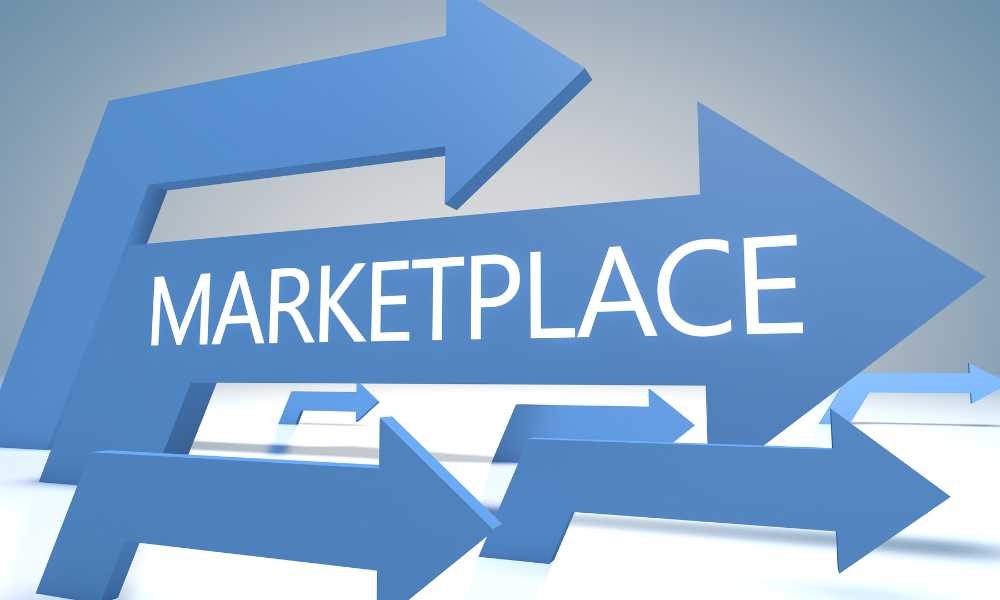Facebook began as a specific social networking site for interacting with friends and family, but it didn’t take long for it to focus on companies and advertising. Given the prevalence of social media eCommerce, studying to offer on the Facebook marketplace is a terrific method to expand your business.
In the following guide, we’ll go through critical tried-and-true tactics for selling on Facebook Marketplace.
What is Facebook Marketplace?

In 2016, Facebook introduced The Marketplace, which quickly became a popular area for users to sell things to people in their immediate vicinity after its inception.
When compared to Craigslist, using Facebook Marketplace to sell locally is a better option because it is both safer and easier to use.
Facebook further differentiates itself from Craigslist by granting qualified merchants the ability to provide nationwide shipping for goods in specific categories. This grants the merchants access to a significantly more significant customer base than is available to sellers who are limited to the local market only.
What size? Facebook alone has a stunning 2.9 billion monthly active users, while the Marketplace alone has an estimated 800 million monthly users.
Due to the fact that it started out as a local buy/sell platform, the Marketplace is frequently misunderstood as a central location where people bring their unused or unwanted household items to be sold.
However, due to its shipping capabilities, it is also great for retail arbitrage. Retail arbitrage is the practice of purchasing high-demand things from a traditional store and then reselling them online in order to make a profit.
Spend some time exploring the Marketplace if you’re unfamiliar with the many things that are offered. You can buy and sell almost everything on sites like eBay or Craigslist, including automobiles, couches, video games, furniture, and more.
Who should sell on Facebook Marketplace?

Anybody, to sum it up! The Facebook Marketplace isn’t just for folks with spare items they want to sell; it’s also for business owners, e-commerce companies, Amazon sellers, handmade artists, woodworkers, brick-and-mortar establishments, you get the idea.
There are a few differences between dealing methods on Facebook and those on sites like Amazon and eBay.
If you’re selling locally, Facebook doesn’t charge you anything to list your goods, unlike other e-commerce or reselling marketplaces. The vendor only has to pay 5% of the sale price if a consumer orders shipping. For the novice and seasoned eCommerce entrepreneurs, listing products on Facebook is a no-brainier due to the low overhead.
Requirements to begin selling on Facebook?

A valid Facebook account is needed to start selling on Facebook Marketplace. Indeed, it’s as simple as that! If you wish to offer to ship on your listings, you’ll have to go through the extra work of providing your payment and shipping data.
A Step-by-Step Guide: Facebook Marketplace Selling
If you are still reading, I’m going to assume that you chose to sell on the platform because it would be profitable. Here are 7 strategies to increase your profit margins while selling on Facebook Marketplace.
1. Create an account on Facebook Marketplace.
2. If you don’t have a Facebook account, create one now. Your regular Facebook account will suffice; you don’t need to create a unique one. Alternatively, you might utilize a seller profile with a specific page. Just be sure to enter every piece of information as precisely as you can.
2. To connect with your audience and boost sales:
- Let your personality and sincerity shine through on your page.
- Create a complete account for this with all the necessary information, such as your location, profile picture, and other facts.
- Make sure to include all the information.
- Selling on Facebook Marketplace begins with this.
- 3. Finding Items to Sell on the Facebook Marketplace
It’s a little more complicated than you might expect to do this. You can sell almost anything on the Facebook Marketplace, just like you do on Craigslist or eBay. But in order to maximize your profits, look for in-high-demand goods like those on this list of popular products.
You should research your rivals as well. For example, how do they provide product descriptions? Additionally, make sure you adhere to standard practices for e-commerce product photographs. Make use of a high-resolution camera to take clear pictures in favorable lighting. Add a thorough explanation of what you are offering, then set a fair price.
3. Conduct Product Analysis and Research
Conducting some preliminary product research is one of the best methods to optimize your profits while selling on Facebook Marketplace successfully. Before listing your products on Facebook Marketplace, consider your target market.
Many online retailers overlook this stage, but in order for Facebook to be effective in generating sales, you should focus on selling products that are in high demand.
Thankfully, finding information about products is simple. Discover what is in demand first. To find out what locals in your area are searching for most, utilize Google Trends.
Then, to find the best offers, search for suppliers on online marketplaces like AliExpress. Select goods with respectable profit margins. While most users use the Marketplace to sell one-off things, there are many programs available, such as Jungle Scout, that can be used to predict sales statistics on more prominent marketplaces like Amazon. This will enable you to improve your Facebook marketing approach and sell similar products by giving you a better understanding of what sells on those significant platforms.
It goes without saying that you are not required to do your investigation using any third-party software. By simply looking at similar pages, you may gain a better understanding of demand, profitability, and what your competitors are doing. If you’d like, you can also differentiate your products using special e-commerce packaging.
4. Choosing a Product to sell on Facebook Marketplace
You can sell a wide range of goods in numerous categories on the Facebook Marketplace. These consist of the following:
- Deals
- Electronics
- Entertainment
- Vehicles
- Housing
- Home and Garden
- Hobbies
- Housing
- Family
- Clothing
It’s also vital to keep in mind that not all products may be offered via this channel. These consist of the following:
- Adult toys
- Alcohol
- Human parts or fluids
- Tobacco products
- Recalled products
- Digital accounts or subscriptions
- Virtual currency
- Hazardous materials
- Gift cards
- Event tickets
- Weapons
- Drugs
- Gambling services
- Medicinal products
5. Demand Forecasting
How do you ascertain what consumers are looking to purchase? What’s more, how can you predict which goods will be in more demand down the road so you can stock up?
An intriguing case study focused on a few businesses that were among the first in Wuhan to learn about COVID-19 months before it spread to the West. They ultimately spent millions on gloves and masks because they anticipated the unavoidable. As you can expect, they made a tonne of money after the illness spread across the nation and people started to buy masks and gloves in large quantities.
Observe new auxiliary products while calculating demand. For instance, both Sony and Microsoft debuted new systems in the previous year. Numerous businesses quickly released licensed alternatives, including controllers, headphones, and additional products, all based on these gaming systems.
Keep up with trends surrounding new releases of well-liked products, and consider whether you may provide auxiliary products to increase your sales even more. You have to look hard and search the web to discover what’s popular if you want to find those rare products. You can make those nice gains with the help of these products.
Market Place Product Posting Instructions
Setting up your store is the next stage. This involves making sure the products are presented correctly and adding them to your Facebook store. Knowing when and how to post on Facebook Marketplace can make a huge difference.
1. Create Listing
Creating a new listing is the first step. You may select Marketplace in the menu on the left of your Facebook News feed to check it out. From there, select Create Listing to see the available choices. Select the listing type you desire.
2. Gather and Add Details about your Product
The next step is to enter the information about your item, images, the asking price, and anything else you’d like to provide. After that, simply click “Next” to obtain a preview. On the following page, you can publish your listing from there.
Be as descriptive as you can while adding details. For example, you should describe its state, how it has been utilized, and any other information you wish to include. Make sure the purchaser understands precisely what you are selling. In this manner, only the description will be used to address all of their inquiries.
3. Optimize and Boost Your Listing
You can also upgrade your listing to increase the number of people who see it. The duration of your post can be chosen by clicking “Boost Post” in the top right corner. Additionally, you need to outline your promotion budget.
You will first need to pay in advance in order to increase the post. Payment options include using PayPal, a credit or debit card, or internet banking. Complete the form, then confirm your payment. The post will immediately receive a boost.
4. Choose Your Audience
When you’re finished, you can choose which groups you want to put the listing in. This is an excellent technique to increase interest in your property and fast generate more offers. Multiple groups can be selected by clicking on them, and the listing will be posted there immediately.
5. Mark as Sold if Items are not available yet
You only need to label your Product as sold after it has been sold. By doing this, people will be aware that the Product is no longer offered and won’t bother you with queries or requests for information.
6. Take Advantage of Facebook Advertising
In order to determine whether you are collecting the appropriate amounts from your consumers, check a few price comparison websites. It’s time to look at more sophisticated selling strategies after you are confident that you are providing value.
You can “boost” your posts on Facebook, which is just a fancy way of saying that you may advertise them there. Click “Boost Listing” after going to “Listings” in your account.
You may specify the promotion’s duration and daily budget, and Facebook will take care of the rest. Facebook also gives you a chance to customize your audience before monitoring the effectiveness of your postings. You will find it simple to assess the results of your promotional spending as a result. Once you get going, you can also employ a variety of up selling strategies to boost your earnings.
7. Treat Your customers Politely on Facebook Marketplace
When selling on Facebook, customer service must be your top concern. Keep in mind that there are other competitors in the industry. Others that are selling the same things as you will compete for your clients.
The most excellent approach to stand out and sell profitably on Facebook Marketplace is to respond quickly to customer inquiries. This will set you apart from the competition and bring in additional clients.
Additionally, be careful to answer all messages and comments left on your postings. For the greatest possible exposure for your brand, you can also speak with eCommerce specialists.
Final Thoughts
It’s essential to learn how to sell on Facebook Marketplace if you want to grow your company or business and make good sales. It’s a great strategy to protect your earnings and increase your revenue. Additionally, selling on Facebook will increase the amount of social evidence your business/brand or company has, enhancing its reputation.
Check out: What is Facebook Marketplace and How Can You Use it?

